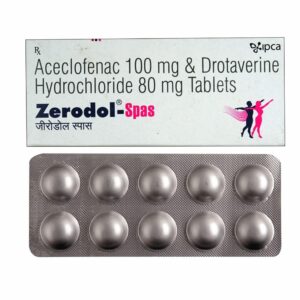ACECLOFENAC + DROTAVERINE
Aceclofenac: Aceclofenac is a nonsteroidal anti-inflammatory drug (NSAID) that is commonly used for the treatment of pain and inflammation associated with conditions such as osteoarthritis, rheumatoid arthritis, and ankylosing spondylitis. It belongs to the class of NSAIDs known as the phenylacetic acid derivatives.
The mechanism of action of aceclofenac is similar to other NSAIDs. It works by inhibiting the enzyme cyclooxygenase (COX), which is responsible for the production of prostaglandins. Prostaglandins are chemicals in the body that contribute to pain, swelling, and inflammation. By blocking the production of prostaglandins, aceclofenac helps to reduce pain and inflammation.
The usual dose of aceclofenac is 100 mg twice daily. It is usually taken with food or after meals to minimize gastrointestinal side effects. However, the exact dosage may vary depending on the individual’s condition and response to treatment. It is important to follow the dosage instructions provided by the healthcare professional.
Common side effects of aceclofenac can include gastrointestinal symptoms such as stomach pain, indigestion, nausea, vomiting, and diarrhea. Less frequently, it may cause dizziness, headache, drowsiness, skin rash, and allergic reactions. Aceclofenac can also have an adverse effect on the liver, so it is important to monitor liver function regularly while taking this medication. Individuals with a history of liver disease or significant liver impairment should use aceclofenac with caution.
As with any medication, it is important to discuss the potential risks and benefits with a healthcare professional before starting aceclofenac. They can provide guidance on the proper use, potential interactions with other drugs, and monitor for any potential side effects or complications.
Drotaverine: Drotaverine is a drug that is primarily used for the treatment of spasms and pain associated with various gastrointestinal and genitourinary disorders. It is commonly prescribed for conditions such as irritable bowel syndrome (IBS), urinary tract infections, renal colic, and menstrual cramps.
The mechanism of action of Drotaverine involves the relaxation of smooth muscles within the gastrointestinal and genitourinary systems. It works by inhibiting phosphodiesterase-IV (PDE-IV) enzyme and calcium influx, leading to a decrease in intracellular calcium levels. This ultimately results in smooth muscle relaxation and relief from spasms and pain.
The recommended dose of Drotaverine may vary depending on the condition being treated and the individual patient. Generally, it is prescribed as an oral tablet or as an injectable solution. The usual dose for adults is 40-80 mg taken orally, three times a day. For intravenous or intramuscular injection, the recommended dose is usually 80-120 mg, two to three times a day.
Like any medication, Drotaverine can potentially cause some side effects. Common side effects include dry mouth, constipation, dizziness, nausea, and headache. These side effects are usually mild and transient. However, in rare cases, more serious side effects such as allergic reactions, irregular heart rhythm, or severe drowsiness may occur. If any unusual or severe side effects occur, it is important to seek medical attention immediately.
It is worth noting that Drotaverine should be used with caution in certain patient populations, such as those with liver or kidney impairment, as well as in pregnant or lactating women. It is always advisable to consult with a healthcare professional before starting any new medication to ensure its safety and appropriate use.

